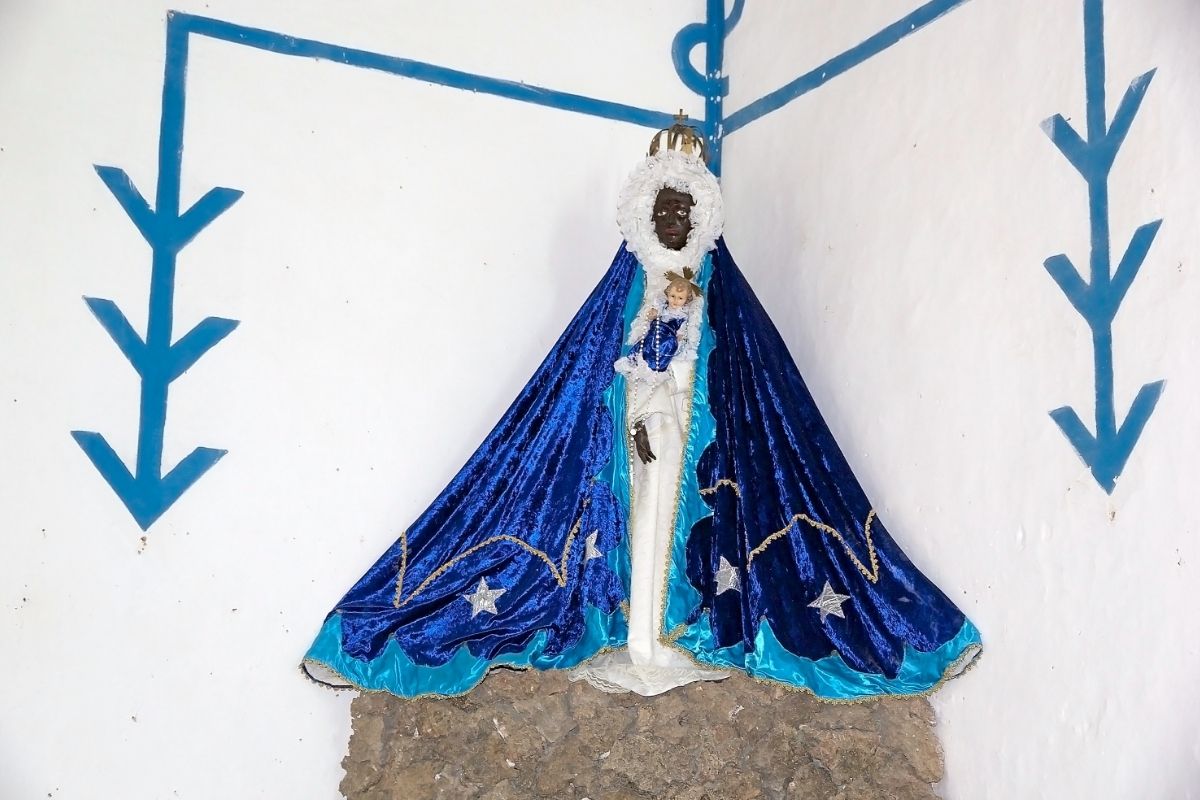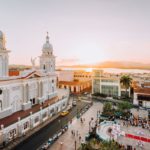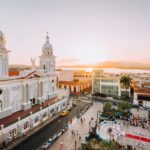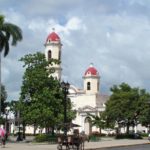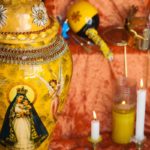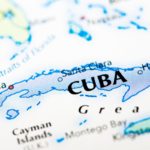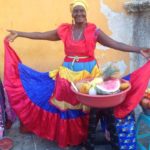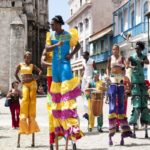However, the prevalent religion is Roman Catholicism, which was established by Spanish colonists when they first traveled to America.
Like any other country colonized by Spanish Catholics, Catholicism in Cuba has penetrated deeply into its population and has long been its official and dominant religion.
Today the Catholic Church is strong and continues to be prestigious, despite the Cuban revolution and independence periods.

Nevertheless, centuries ago, the arrival of slaves from the African continent changed the religious composition and there is another religion, Santeria, that is quite popular too.
Hundreds of years later, and following the Cuban revolution that ended in 1959, the state attempted to restrict religious activity and forbid monetary donations and funding from unregistered entities.
In addition to that, during that decade the Cuban state has also been constitutionally declared an atheist state to further accentuate its non-religious character.
It was only during the 90s that the Cuban began to lessen its supervision and surveillance of religious activity, allowing for greater freedom.
The attempts of Cuba to become a non-religious state and promote atheism did work to a great extent as atheists also form a large (non-)religious group in the country.
But let’s get into more detail and delve deeper into the details of each religion in Cuba.
Religious Beliefs In Cuba
Christianity According To Roman Catholicism
Roman Catholic Christians account for around 59 percent of the overall population in Cuba.
At the beginning of the mass uprising, the Catholic priests teamed up to protest the governing Communist Party.
Even while the party did not forbid Christianity or other religions for that matter, it set a rule that did not allow for any religious member to become a member of the party.
The state also actively encouraged people to be atheists, which resulted in a constant tension between the church and the government.
Following Fidel Castro’s election, the Catholic Church saw a significant reduction in its membership and followers.
A characteristic example of that was the low number of baptisms that were taking place, with the numbers being as low as 7000 baptisms annually.
However, with the fall of the Soviet Union in 1991, the government softened its stance toward Catholics, while Pope John Paul II’s visit seven years later was viewed as a positive move towards fostering greater religious freedom.
Around that period, the government also secured more visas for the Catholic priests to travel to Cuba and participate in communal activities with other religious people living in the country.
This relaxation, however, was brief and probably too good to be true for the Cuban religious people, as the government didn’t wait long until they resorted to strict control once again.
Agnosticism – Atheism
Cuba is nominally an atheist country, and it has attempted to spread this concept among its population, without this meaning that it restricts other religions.
There is a considerable amount of atheist people living in Cuba, who account for around 23 percent of the entire population.
The revolution’s success inspired many individuals who wished to participate in it to leave their beliefs, and yet, with the present leader occasionally attending religious services given by worldwide spiritual leaders, the number of atheists in the country seems to be decreasing.
Protestantism And Other non-Catholic Christian Denominations
Because of reduced government involvement, Baptists, Pentecostals, and Seventh Day Adventists, among other organizations, have also infiltrated the nation and gained members.
Because of less government control and intervention, these religions exhibit a greater success in acquiring new believers, importing religious literature, and going on holy missions.
In addition to Santeria in Cuba, we have Spiritism, of American origin, which arrived on the island in the mid-nineteenth century and had its consequences when the Spaniards and the African mixed again.
On the other hand, in Cuba there are people who practice Judaism, there are many synagogues, and among other religious groups, we see Buddhists, Confucians, and Protestants.
The latter managed to overcome the Catholics’ resistance during the first decades of democracy, although they are not in the majority.
And of course, there are also many Cuban communists and atheists. An entire crucible of religions.
However, while all these religions and non-religions are known to most of us, what might not be that well-known is Santeria, which we have left for last, but certainly not least.
Other African-Caribbean Folk Beliefs Including Santeria
Santeria, known as “worship of the Saints,” has grown in popularity as a religious practice in Cuba.
It emerged in the 18th century amongst the groups of slaves who were brought from Africa and who lived on the island’s sugarcane fields.
Nowadays, Santeria’s supporters account for around 12 percent of the total population in Cuba.
It is a comparative religion that incorporates parts of the Roman Catholics’ Christianity established by the Spanish colonists whilst retaining the core values of Africa’s enslaved Indigenous Peoples, particularly those of the Nigerian Yoruba tribe.
Therefore, it is a fusion religion of ancient African traditions and Roman Catholic Christianity.
Santeria, being a practice founded in an oppressive culture, is distinguished by its secrecy, having survived first the merciless slave owners and colonial power, and later the Fidel Castro’s government’s restrictions.
Santeria, as a hybrid faith that mixed African customs with Catholic ideas, allowed communities to keep their old beliefs while appearing to worship Catholicism.
Santeria was once a slave-only practice, a rejection of the deities of Catholicism and the colonialists’ Christian God.
The first religious practices took place in the slaves’ social centers (calbidos) of the little community of Palmyra.
On a monthly basis, Cuban slaves met there to celebrate the powers of the Olodumare, through whom the deceased were said to interact with the higher Creator.
Apart from their God, Olodumare, the Yoruba tribe people also adore hundreds of other spirits known as “Orishas,” who personify parts of nature and spirit.
Elegba, Oggun, Ochosi, Obatala, Oshun, Chango, Oya, Babalu-Ayé are some of the main Orishas.
Orishas are semi-divine entities that each represent a different facet of human existence. Ochun denotes romantic love and money, whereas Oggun represents battle.
Chango represents desire and masculinity, whereas Babalu-Ayé represents healing.
As we said, to protect their religious traditions from Catholic pressure, African people combined the Orisha spirits with the saints of Catholicism.
As a result, Shango became known as Santa Barbara, Obatala as Our Lady of Mercy, and so on.
The religion gained a stronghold among African communities, particularly in Brazil and Cuba, and ultimately extended to mixed-race and European-American groups in these nations.
Following the revolution in Cuba in 1959, Santeria, or “La Regla de Ocha” as they called it in Spanish, expanded to the US, especially in states like New York City and Florida, but also in other countries in Latin America like Venezuela and Puerto Rico.
Each Orisha receives one day a year dedicated to them. Tambours and dance festivities (called drumming) are the main characteristics of Santeria’s worshipping and celebration.
For the tambours, extensive altars are built, and followers of Santeria will summon Orishas with song, dancing, and ceremonies in which they will sacrifice food, rum, and animals in the present spirit.
Based on the type of the festivities, instrumentalists and percussionists with bata drums perform exact rhythmic patterns targeted directly to particular Spirits whereas the people who attend the ceremonies recite call-and-response songs in the archaic Yoruba language, known as Lucumi, in an attempt to invite the Orishas to come down to Earth and possess the bodies of their dedicated Santerían priests.
Moreover, it is important to note the big influence Yoruba religion has had on music, as the sounds and patterns of Yoruba worship have been crucial to the creation of various types of African American music, from gospels to jazz and blues, as well as musical styles such as Salsa and Latin Jazz.
And, if you are interested in learning more about it, “Flash of the Spirit: African & Afro-American Art & Philosophy” by Robert Farris Thompson, which you can purchase in paperback on Amazon, is a valuable resource for tracing the origins of African American culture in faiths of African tribes, including Yoruba.
In fact, Santeria is practiced by several well-known Latin artists. For example, Carlos Santana has blended Orisha patterns and beats into various tracks of his, like “Hannibal,” which incorporates a Yoruba hymn to Shango.
What is weird, however, is that while the Yoruba culture and faith are gaining ground in the New World, it is slowly being replaced in Nigeria by both Islamic and Christian strains, particularly that of Evangelical Protestantism.
The presence of oral tradition has ensured the survival of this faith over the years.
Believers pass on, maintain, and promote their principles to future generations.
Santeria has risen from the shadows of a Cuban society that now has the freedom to carry out its religious responsibilities and is seeing growing acceptability as well as popularity.
Santeria, like other comparative religions in Latin America, provides a method for modern Cubans to reconcile a shattered past.
After decades of secrecy, Santeria is now openly practiced, with people from all walks of life taking part.
Santeria is a cultural legacy, a dynamic style of worship, and an entirely Cuban religion that represents a shared identity.
Santerian Beliefs In Detail
Cosmology
The Santerians’ Yoruba cosmology consists of a five-tier authority system.
The greatest God is Olodumare, also known as Olorun, and he is the one everyone believes in. Then come the Orisha Spirits, followed by humans, and then their ancestors.
The last group in power is that of other earthy creatures and organisms like animals, and plants, as well as elements of nature, other natural forces, and man-made goods.
Olodumare is the highest source of “ashe,” the Higher power that makes up the cosmos, everything that is alive, and everything that is in material or soulless form. Therefore, Olodumare is equivalent to the Catholics’ Jesus Christ.
Orishas
We’ve already mentioned Orishas, but what exactly do these spirits do and what does each one of them represent?
Olodumare communicates with the rest of the world through messengers known as Orishas. Orishas have control over all natural forces as well as all aspects of human existence.
They may be reached by people who are praying, through ceremonial offerings, and spirit possessions, and are relied on to help believers and direct them to the right path towards a better earthly and spiritual existence.
Every single one of the Orisha spirits is assigned a unique number and color, as well as “favorite items” such as a meal or day in the week.
A Santerían devotee can use the colors to bead necklaces representing the Orisha they choose to honor.
This way, if a Santerían wants to offer something to a specific Orisha spirit, he or she can use their different color to distinguish them and make their offering solely to one of them.
Each one of the Orishas is responsible for guarding a certain sphere of human life.
However, because there are thousands of Orisha spirits in the Santerian religion and it would take us forever to research them, we shall only present you with eight of them that are considered to be amongst the most popular ones.
Elegba, Ogun, And Oshosi
The first three Orishas are named Elegba, Ogun, and Oshosi, and they are known as “the Guerreros” or Warriors.
As you might be able to tell from that, they are the guardians of wars or those who oversee the human conflicts and battles.
Elegba: The Orisha Of The Crossroads
Elegba, or Eleggua, is a divinity in Yoruba cosmology. He is the proprietor of our world’s roadways and gates, the link between humans and the holy, the celestial messenger of Olodumare, and the mediator between him, the Orishas, and mankind.
Whenever a believer wishes to say a prayer, they first invoke Elegba, who opens the channels of communication between the human world and or the Orisha spirits.
Without Elegba’s approval, Santerians can’t do anything in either the human or the divine world.
Eshu Eleggua, Èlegba, or Èlegbara is the name he is known with amongst the Lucumí or Yoruba followers of the New World, and he is adored throughout West Africa and the Diaspora.
Using “Eshu” in his name is a form of sacred praise, known as “oriki,” which is used to define the qualities of an Orisha spirit or to explain the adjectives that characterize it.
Legba is his Fon name, but in countries like Brazil, he is called Exu by people who practice the Candomble religion, which translates as “dance in honor of the gods”.
His equivalent in Catholicism is Saint Anthony, while his color of worship is both red and black, and his number is three.
Ogún
Ogún (also seen as Oggun, Ogou, or Ogum) is a brave warrior who protects his followers and battles injustice.
He is an Orisha spirit representing both aggression and honesty, as well as intelligence and creativity that helps people create tools, build machines and weaponry, and evolve in the field of technology.
Iron, warfare, and work are all associated with this deity. Once Elegba unlocks the gates, Ogún clears them up with his machete.
He is considered by many as the father of civilization as it was thanks to his prowess that the way from orun (heaven) to ayé (earth) was paved, allowing humans and the orishas to come to earth. He is also the single Orisha spirit that has authority over death and life.
Ogún lives in the world’s wild outdoors and woodland locations, and it was his tools and efforts that helped him succeed in building new cities, houses, and roads after getting rid of the wilderness.
However, all these skills and characteristics of his have led to Ogún’s ambiguous nature, as he has the power to wield his machete and either murder someone or rescue them in a case of emergency.
He is frequently seen foraging with his closest companions Elegba and Oshosi.
Ogún might be a devoted parent who works constantly in his forge inventing new weapons, or he can be a ferocious fighter who wields his machete and kills his foes.
At times, he can also be the most brilliant of surgeons, one who treats cancer and offers people a second chance in life.
Santeríans celebrate Ogún in their altars for his protective disposition and his ability to stimulate people’s minds and ignite creativity in their brains.
His equivalent in Catholicism is Saint Peter, while his colors are green and black, and his number is seven.
Oshosi
In Santerian religion, Oshosi, also called Ochossi, Ochosi, or Oxosi, is a heavenly warrior guardian, hunter, and the personification of fairness.
He was an extremely talented scout and was rumored to be the best archer to have ever lived.
Oshosi was famous not just for his scouting skills but also for his clairvoyant powers. His significance in Yoruba mythology is equal to that of his relatives.
According to Yoruba folklore called “patakis”, Oshosi resided in a big cauldron made of iron along with his brothers, Elegua and Ogun. Even though they were brothers, they did not have the same mother.
Oshosi’s mother was thought to be Yemaya, the sea deity, but Elegua and Ogun’s mother was Yembo.
Based on some old texts, Ochosi was a skilled hunter and fisherman with shamanistic powers.
In Yoruba, he is frequently represented as a young person, sporting a headdress ornamented with a feather and horns and holding his arching equipment.
He is also frequently depicted next to Ogun because they were almost always supposed to be working together.
Oshosi and Ogún’s relationship wasn’t always the best, but they regularly put their differences aside to partner up for a higher cause.
According to Yoruba cosmology, the brothers agreed that Oshosi would be the hunter and Ogún would open the road for him to do so. Because of their deal, they always got along and were inseparable.
Furthermore, Oshosi has a tight friendship with Obatala, or “Orisa Nla” (the father of the Orisha Spirits), and serves as his interpreter.
He directs human existence by advising people to comply with the regulations of the civil societies to which they belong.
His equivalent in Catholicism is Saint Norbert, while his colors are blue and yellow, and his numbers are three and seven.
Obatalá: The Father Of The Orisha Spirits And Of Humanity
Obatalá (sometimes spelled Obbatala or Obatala) is the elder Orisha Spirit in Santeria and the monarch of orun (heaven).
He is also the father of numerous orishas, and as such, the other Orisha spirits regard him with tremendous respect and are very loyal to him, especially when it comes to important matters.
In addition to that, he serves as a “referee” and judge whenever the Orishas disagree, seeking to maintain the order.
He is the creator of all things on heaven and earth and the enforcer of justice in them.
He is the origin of everything pristine, wise, serene, decent, ethical, and merciful.
That is why in a worshipper’s home, Obatalá’s monument is usually positioned above other Orishas’ shrines to signify his status in the Lukumi pantheon.
Along with Oshun, Yemaya, and Changó, Obatalá is the fourth Orisha spirit that every person who wants to be initiated gets during their “kariocha” (meaning initiation).
His roads are distinctive in the sense that they are equally split into male and female, which means that Obatalá is an impartial Orisha spirit transcending gender.
This trait of his further accentuates his fairness and justifies his role as the father of all Orishas.
And, if there is any doubt regarding who a person’s Orisha guardian is, they are usually initiated with Obatalá.
What is more, Obatalá is considered the possessor of all human heads since he shaped the human bodies before Oloddumare instilled life in them.
As a result, he is the protector of humankind and guards everyone who comes to life and is not yet aware of who their guardian is of all the Orisha spirits.
His equivalent in Catholicism is the Lady of Mercy, while his color is white as he is an amalgam of all spirits and colors, and his number is eight.
Most of the time, he is depicted as an elderly man with white hair and a white robe.
Chango
Changó (also seen as Shangó, Ṣango, or Xango) is another one of the most popular Orisha spirits.
He is the ruler of thunder and lightning and king of the Yoruba religion on Earth. Like the brothers Elegba, Ogun, and Oshosi, he is also a warrior.
He is the Orisha spirit that expects people to live their lives to the fullest and wants them to be actively involved in them.
He encouraged people to embrace everything life has to offer them while fostering diplomacy and regal elegance.
Some could say that he is the most fun spirit of the Orishas, as he is well-known for his love for partying, drinking, and eating, as well as having several female partners and spouses.
He is also the spirit of dance, drums, flame, masculinity, and leadership.
Changó was once a living ruler on our planet, who served as the fourth Alafin of Oyó on the land of Yoruba.
Even though he was not very efficient as a ruler during his living monarchy, he is said to have done miraculous work when he ascended to heaven and became an Orisha spirit.
As for his circumstances of death, any discussion regarding them is frowned upon by Santerian believers.
Moreover, he is a renowned sorcerer who creates unbreakable spells in his mortar (called Odó), like the one that gives him the ability to spew fire.
As for his preferred piece of weaponry, that is the double-headed ax.
As we’ve already said, Changó is one of the four pillars of Santeria, along with Obatalá, Oshun, and Yemaya.
His equivalent in Catholicism is Santa Barbara, while his colors are red and white, and his numbers are four and six.
Oyá
In Santeria, Oyá (also spelled Ollá, Yansa, or Yansán) is a strong and formidable female Orisha warrior.
She is the Orisha of wind and whirlwind and the guardian of the fallen and the graveyards’ gates, while she also controls the bolts of lightning and wields the wind during battles. She is powerful, chaotic, shifting, and protective.
Oyá was once married to Ogun, who created her favorite piece of weaponry, the machete, but she then abandoned him to become Chango’s lover.
She was the only one of Chango’s lovers who was actually capable of keeping him away from his acts of recklessness, but only because she stole his lightning secret and took advantage of his fear of the dead to control him.
According to Yoruba folklore, to win her fights Oyá summons the dead and uses them as her army and tornadoes as her weapons.
However, contrary to popular belief, she does not dwell in the graveyard. She lives in the marketplace and guides the shifting fortunes of commerce.
She owns the graveyard gates and will accompany the souls of the deceased to the cemetery’s entrance, but it is Obba and Yewá who actually reside there.
However, she is more than just a warrior deity. Oyá is also the driving force behind the transformation in both life and nature.
She is a multifaceted Orisha spirit who has been through a lot. She is recognized as the “mother of nine,” referring to her nine stillbirths.
D S deeply saddened by her inability to bring a kid to life, she wears nine various colored scarves around her waistline to honor her stillborn children.
Oyá is related to many of the Orisha spirits we’ve already mentioned, like Ogun, and Changó.
She was also very close to Oshún, who when once told her twins, the Ibeji, to leave her home, Oyá adopted them and nurtured them as if they were her children.
In Catholic religion, her equivalent deities are Lady of the Presentation of Our Lord and Saint Theresa, while her colors are maroon and white, and her number is nine. She is usually depicted fighting with her machete next to her beloved Changó.
Oshun
Oshun (also written Ochn, Oun, or Oxum) is the youngest of all Orishas, the world’s last spirit created from Olodumare’s passion for creating.
She is the ruler of all waters, including rivers, streams, and brooks.
She is also the embodiment of love, grace, and reproduction, and she symbolizes the blood that flows through the body and gives rise to human existence.
She’s also linked to culture and the creative arts.
Seeing that she is the Santerian deity of love, beauty, femininity, and sensuality, many people relate her to Venus or Aphrodite.
However, such a comparison is flawed since Oshun, thanks to her vastness and power, embodies the whole spectrum of femininity.
Oshun holds every woman’s tale inside her patakis, from the youthful, eager seductress who flirts with males to the aged matriarch with bad hearing, who is sitting in her rocking chair and reminiscing her young years.
Oshun holds every woman’s tale inside her patakis, from the youthful, eager seductress who flirts with males to the aged matriarch with bad hearing sitting in her rocking chair reminiscing her young years.
She makes her home in the world’s waterways. She is the woman behind everything sweet and soft in life, as well as all the things that make it worthwhile.
In the Catholic religion, her equivalent deity is the Lady of Charity, while her colors are yellow and gold, and her number is five.
Babalú-Ayé
Babalu-Ayé means “Father, Lord of the Earth,” indicating the spirit’s control over everything that exists on Earth, such as the body, riches, and material belongings.
He is also an Orisha connected mostly to sickness and infections.
This Orisha spirit was negatively linked with smallpox outbreaks in West Africa, and in the modern West World, he is more frequently seen as the patron of diseases like leprosy, influenza, and HIV.
Yet, and even though Babalu-Ayé is primarily linked with illness and disease, he is also the deity who cures these afflictions. Therefore, many people pray to him hoping that he will help them recover.
Babalú-Ayé is a spirit that people both fear and love, with believers also calling his “the Wrath of the Supreme God,” as he is the punisher of those who transgress.
As a matter of fact, Santeríans do not call Babalú-Ayé by his name for fear of leading him to spread epidemic diseases.
As he is strongly related to Earth and living beings, he is worshipped in shrines that are located away from busy areas that are full of traffic.
In the Catholic religion, his equivalent saint is Saint Lazarus; not the one who was resurrected but the poor leper whose dogs licked his sores, as described in Luke’s Gospel.
His colors are light blue and white, and his number is seventeen.
Orisha Oko
Orisha Oko is in charge of crops and agriculture and is usually described as a veteran hunter who switched to farming. As a result, he is the deity in control of all the gardeners’ equipment.
In Orisha portrayals, Orisha Oko is frequently portrayed as the one who resolves arguments amongst the Orisha spirits, especially those between the women, and even more those between Chango and his lovers.
But these aren’t simply ordinary disagreements: they’re mostly witchcraft charges, to which Orisha Oko is no stranger.
Orisha Oko is intimately related to witchcraft practices in agriculture. He is Earth’s sorcerer protecting people from spells and curses and remedying their consequences.
In Africa, Orisha Oko is still a deity intimately tied to witchcraft. However, since witchcraft charges were not that important in comparison to other hardships throughout the establishment of African Diaspora religions, Orisha Oko remained mostly known in the West World as the god of agriculture.
Disputes over charges or suspicions of witchcraft were usually settled by ceremonies performed at his temples, and his worshippers are mostly female, with devotion to him being passed down from one generation to the next. In Catholic religion, his equivalent saint is Saint Ysidro, while his color is lilac.
Ọsanyin
Ọsanyin, also known as Osaín, Ossain, or Ossaímis, is the Orisha spirits’ doctor.
He has command over all herbs that can be used for witchcraft or to make medicine. The ceremonial drums are dedicated to him.
Ọsanyin is nature’s Orisha spirit who rules over the woods and wild regions, as well as over the herbs and treatment. He is the guardian of hunters, even though he is also a veteran hunter.
This is another multifaceted Orisha spirit, as Ọsanyin is also a protector of houses and a rational spirit, even though some Yoruba folklore describes him and the rest of nature’s Orishas as uncontrollable and wild.
Even though he used to have a human figure like all Orisha spirits did, according to mythology Osian lost many parts of his body – including one ear, leg, arm, and eye.
It is also said that the one eye that was left moved to the center of his face, making him look like a Cyclop.
In the Catholic religion, he is most identified with Pope Saint Sylvester I, but he is also related to several other saints like Saint John, Saint Ambrose, Saint Anthony Abad, Saint Joseph, and Saint Benito.
His colors are yellow, red, green, and white.
- Roman Catholic Christianity: 59%
- Atheism or Agnosticism: 23%
- Santeria and Other African-Caribbean Folk Beliefs: 12%
- Protestantism and Other Non-Catholic Forms of Christianity: 5%
- Other Beliefs: 1%
The Bottom Line
Religious activities are expanding in Cuba as the Communist Party’s grip over the churches dwindles.
Except for atheists, most Cubans are religious and participate in numerous rites and ceremonies to gain God’s favor.
The government’s attempt to propagate atheism is weakening its hold on the country, while Santeria is becoming more popular amongst people who are not only living or traveling to Cuba, but also amongst those in other countries in South America and states of the USA.
- What Is The Largest Island In Cuba? - September 19, 2022
- Havana – Why Is It Cuba’s Most Exciting City? - September 19, 2022
- Cheapest Time To Visit Cuba (Ultimate Guide) - September 19, 2022

